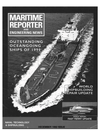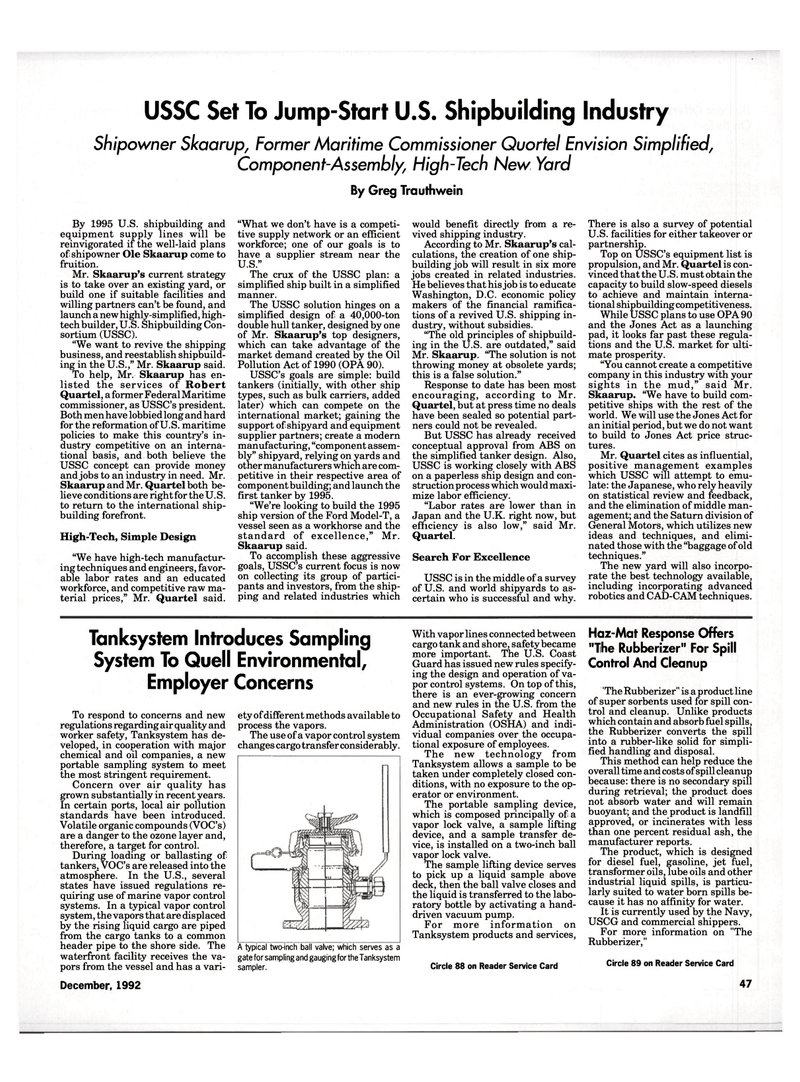
Page 45: of Maritime Reporter Magazine (December 1992)
Read this page in Pdf, Flash or Html5 edition of December 1992 Maritime Reporter Magazine
USSC Set To Jump-Start U.S. Shipbuilding Industry
Shipowner Skaarup, Former Maritime Commissioner Quortel Envision Simplified',
Component-Assembly; High-Tech New Yard
By Greg Trauthwein
By 1995 U.S. shipbuilding and equipment supply lines will be reinvigorated if the well-laid plans of shipowner Ole Skaarup come to fruition.
Mr. Skaarup's current strategy is to take over an existing yard, or build one if suitable facilities and willing partners can't be found, and launch a new highly-simplified, high- tech builder, U.S. Shipbuilding Con- sortium (USSC). "We want to revive the shipping business, and reestablish shipbuild- ing in the U.S.," Mr. Skaarup said.
To help, Mr. Skaarup has en- listed the services of Robert
Quartel, a former Federal Maritime commissioner, as USSC's president.
Both men have lobbied long and hard for the reformation of U.S. maritime policies to make this country's in- dustry competitive on an interna- tional basis, and both believe the
USSC concept can provide money and jobs to an industry in need. Mr.
Skaarup and Mr. Quartel both be- lieve conditions are right for the U.S. to return to the international ship- building forefront.
High-Tech, Simple Design "We have high-tech manufactur- ing techniques and engineers, favor- able labor rates and an educated workforce, and competitive raw ma- terial prices," Mr. Quartel said. "What we don't have is a competi- tive supply network or an efficient workforce; one of our goals is to have a supplier stream near the
U.S."
The crux of the USSC plan: a simplified ship built in a simplified manner.
The USSC solution hinges on a simplified design of a 40,000-ton double hull tanker, designed by one of Mr. Skaarup's top designers, which can take advantage of the market demand created by the Oil
Pollution Act of 1990 (OPA 90).
USSC's goals are simple: build tankers (initially, with other ship types, such as bulk carriers, added later) which can compete on the international market; gaining the support of shipyard and equipment supplier partners; create a modern manufacturing, "component assem- bly" shipyard, relying on yards and other manufacturers which are com- petitive in their respective area of component building; and launch the first tanker by 1995. "We're looking to build the 1995 ship version of the Ford Model-T, a vessel seen as a workhorse and the standard of excellence," Mr.
Skaarup said.
To accomplish these aggressive goals, USSC's current focus is now on collecting its group of partici- pants and investors, from the ship- ping and related industries which would benefit directly from a re- vived shipping industry.
According to Mr. Skaarup's cal- culations, the creation of one ship- building job will result in six more jobs created in related industries.
He believes that his job is to educate
Washington, D.C. economic policy makers of the financial ramifica- tions of a revived U.S. shipping in- dustry, without subsidies. "The old principles of shipbuild- ing in the U.S. are outdated," said
Mr. Skaarup. "The solution is not throwing money at obsolete yards; this is a false solution."
Response to date has been most encouraging, according to Mr.
Quartel, but at press time no deals have been sealed so potential part- ners could not be revealed.
But USSC has already received conceptual approval from ABS on the simplified tanker design. Also,
USSC is working closely with ABS on a paperless ship design and con- struction process which would maxi- mize labor efficiency. "Labor rates are lower than in
Japan and the U.K. right now, but efficiency is also low," said Mr.
Quartel.
Search For Excellence
USSC is in the middle of a survey of U.S. and world shipyards to as- certain who is successful and why.
There is also a survey of potential
U.S. facilities for either takeover or partnership.
Top on USSC's equipment list is propulsion, and Mr. Quartel is con- vinced that the U.S. must obtain the capacity to build slow-speed diesels to achieve and maintain interna- tional shipbuilding competitiveness.
While USSC plans to use OPA 90 and the Jones Act as a launching pad, it looks far past these regula- tions and the U.S. market for ulti- mate prosperity. "You cannot create a competitive company in this industry with your sights in the mud," said Mr.
Skaarup. "We have to build com- petitive ships with the rest of the world. We will use the Jones Act for an initial period, but we do not want to build to Jones Act price struc- tures.
Mr. Quartel cites as influential, positive management examples which USSC will attempt to emu- late: the Japanese, who rely heavily on statistical review and feedback, and the elimination of middle man- agement; and the Saturn division of
General Motors, which utilizes new ideas and techniques, and elimi- nated those with the "baggage of old techniques."
The new yard will also incorpo- rate the best technology available, including incorporating advanced robotics and CAD-CAM techniques.
Tanksystem Introduces Sampling
System To Quell Environmental,
Employer Concerns
To respond to concerns and new regulations regarding air quality and worker safety, Tanksystem has de- veloped, in cooperation with major chemical and oil companies, a new portable sampling system to meet the most stringent requirement.
Concern over air quality has grown substantially in recent years.
In certain ports, local air pollution standards have been introduced.
Volatile organic compounds (VOC's) are a danger to the ozone layer and, therefore, a target for control.
During loading or ballasting of tankers, VOC's are released into the atmosphere. In the U.S., several states have issued regulations re- quiring use of marine vapor control systems. In a typical vapor control system, the vapors that are displaced by the rising liquid cargo are piped from the cargo tanks to a common header pipe to the shore side. The waterfront facility receives the va- pors from the vessel and has a vari-
December, 1992 ety of different methods available to process the vapors.
The use of a vapor control system changes cargo transfer considerably.
A typical two-inch ball valve; which serves as a gate for sampling and gaugingfor the Tanksystem sampler.
With vapor lines connected between cargo tank and shore, safety became more important. The U.S. Coast
Guard has issued new rules specify- ing the design and operation of va- por control systems. On top of this, there is an ever-growing concern and new rules in the U.S. from the
Occupational Safety and Health
Administration (OSHA) and indi- vidual companies over the occupa- tional exposure of employees.
The new technology from
Tanksystem allows a sample to be taken under completely closed con- ditions, with no exposure to the op- erator or environment.
The portable sampling device, which is composed principally of a vapor lock valve, a sample lifting device, and a sample transfer de- vice, is installed on a two-inch ball vapor lock valve.
The sample lifting device serves to pick up a liquid sample above deck, then the ball valve closes and the liquid is transferred to the labo- ratory bottle by activating a hand- driven vacuum pump.
For more information on
Tanksystem products and services,
Circle 88 on Reader Service Card
Haz-Mat Response Offers "The Rubberizer" For Spill
Control And Cleanup "The Rubberizer " is a product line of super sorbents used for spill con- trol and cleanup. Unlike products which contain and absorb fuel spills, the Rubberizer converts the spill into a rubber-like solid for simpli- fied handling and disposal.
This method can help reduce the overall time and costs of spill cleanup because: there is no secondary spill during retrieval; the product does not absorb water and will remain buoyant; and the product is landfill approved, or incinerates with less than one percent residual ash, the manufacturer reports.
The product, which is designed for diesel fuel, gasoline, jet fuel, transformer oils, lube oils and other industrial liquid spills, is particu- larly suited to water born spills be- cause it has no affinity for water.
It is currently used by the Navy,
USCG and commercial shippers.
For more information on "The
Rubberizer,"
Circle 89 on Reader Service Card 47

 44
44

 46
46
